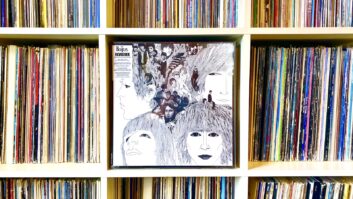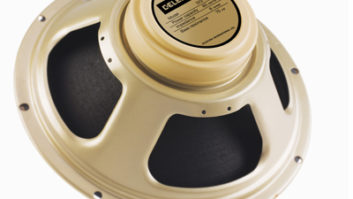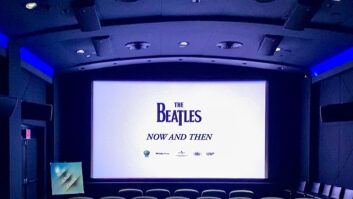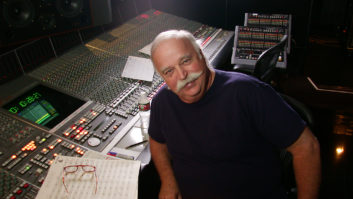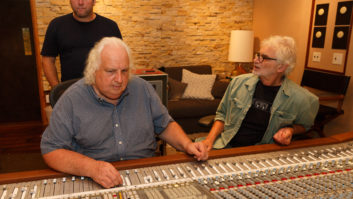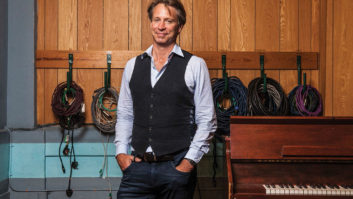A lot of us can relate to Geoff Emerick: a young teenager who used his tape recorder to capture everything he could and wondered how one of those things made phonograph records. That, unfortunately for most of us, is where the similarity stops. We didn’t record The Beatles.
In his recent memoir, Here, There and Everywhere: My Life Recording the Music of The Beatles (Gotham Books, co-written by Howard Massey), the Grammy-winning engineer walks readers through a career that began with listening to classical records in his grandmother’s basement and led to recording such masterworks as Revolver, Sgt. Pepper’s Lonely Hearts Club Band and the White Album. Although The Beatles’ recordings have been well-chronicled — most notably in Mark Lewisohn’s remarkable The Beatles Recording Sessions — Emerick’s book is the first to place the reader inside Abbey Road Studio 2.
Emerick began working at the studio at the age of 15 in September 1962, when The Beatles recorded “Love Me Do.” While climbing the Abbey Road ladder, he had only occasional sessions working under the group’s original engineer, Norman Smith. But at the age of 20, he was asked to become their engineer when Smith moved on to become a producer. The rest is history.
I spoke with Emerick at his home in the Hollywood Hills about some of his Beatles memories.
What was it like to hear a Beatles song for the first time — to have one of them walk in and start playing a new song? How would they introduce a song to the others?
Oh, it was magic. It was all done in the studio. They may have rehearsed it sometimes, perhaps at Paul [McCartney’s] house nearby in St. John’s Wood [London]. But normally, they’d come in with the lyric: “I’ve got this idea for the song, and it goes a bit like this.”
I remember John [Lennon] picking up his acoustic and playing “A Day in the Life” to the rest of them, just saying, “This is how it goes.” And you’d be down in the studio, and you’d think, “My God, that’s unbelievable!” I always remember when we went for the real vocal on that song — shivers ran down our backs as soon as he started singing.
What were The Beatles’ reactions to your taking Norman Smith’s place?
Well, the first session, I was obviously very nervous. I hadn’t slept all night because of nerves. I thought [producer Sir] George Martin would have informed them that Norman wasn’t going to do it anymore. I’ve got a recollection of George Harrison asking George Martin, “Well, where’s Norman?” And then George Martin saying, “Well, Norman’s not doing it anymore.” I was thinking, “Oh, my God, George hasn’t told them.”
I really genuinely felt dreadful. We started doing “Tomorrow Never Knows,” and then we got the vocal sound that John wanted through the Leslie speaker. And he fell in love with that, so I sort of passed the first test, I guess.
Things had always been done pretty much by the book during Norman’s time. What changes did you make?
In Studio 2, the normal arrangement was to have the rhythm section on the carpeted end of the room and the strings and orchestra on the hard floor. I changed it all around and put the rhythm on the hard floor and the orchestra on the dead floor. Now I had a live rhythm section and a dead orchestra sound, and I put on a bit of echo. It all started from there. Looking back on it, it seems so trivial, but, of course, it did change things.
What else did you begin doing differently from Norman’s method, with respect to The Beatles?
Well, one of the first things I did differently — and this was on “Tomorrow Never Knows” — was change the way Ringo [Starr’s] bass drum was recorded because I always used to feel the bass drum sounded weak. And I’d heard other records where the bass drum really thumps out.
How did Norman used to mike it?
Well, the usual fashion for recording drums was you had a stand mic and a hi-hat mic, which were AKG D19s. And I think he used a 4038, which was made by Standard Telephones and Cables [now Coles], for the overhead. Now, there was an AKG D20 on the bass drum. So off came the front skin and I placed it inside, right up close to the other skin — and got into trouble for it because the powers that be said, “The air pressure’s going to damage the capsule,” which is a fair enough statement. Whether it did or not, I don’t know. But I did it, and that day got a special letter from the management saying that on Beatles sessions only, I could move the bass drum mic closer than 18 inches.
How did The Beatles respond to that?
They liked it because we were starting to get into more tracks where the bass drum’s really in your face, and the snare’s a lot more focused. And then Paul began to hear better bass sounds, especially on “Paperback Writer” and “Rain,” which we recorded next.
You did something kind of unusual on “Paperback Writer.”
I was grasping at straws. The theory was to get the power of the bass out; if a loudspeaker could push it out, a loudspeaker could take it in. If you reversed it and placed another bass cabinet speaker face-to-face against the bass speaker, you could use it as a mic. It was as simple as that. I then compressed it, and then compressed it again, EQ’d it and squashed it off, basically.
Of course, the only real way to experience the sound of “Paperback Writer” or “Rain” is to play the 7-inch mono vinyl single. That’s how it’s supposed to sound, with the bass punching out — it really shoots out the speaker unlike the stereo, which doesn’t have that kind of impact.
What kind of gear was there at Abbey Road at that time?
We had a desk with eight mic inputs, with very limited equalization, which was treble and bass — no selective frequencies — an echo chamber and a tape machine. That’s all we had. And then the Fairchild limiters came in, I think, around the time of Revolver.
So there wasn’t a whole lot to work with, other than ingenuity, to come up with new sounds.
No, and they became more demanding, sonically. They’d be saying, “Well, we don’t want that sound. We want this, we want that.” And I had nothing — what could I do? I just had to conjure up these things in my head and try to experiment.
They’d say, “Geoff, we’re gonna do a guitar, we’re gonna do a piano. But we don’t want it to sound like a piano, we don’t want it to sound like a guitar. Can’t we make it sound different?” Remember, when I was working with them, we didn’t have any great boxes to put on the guitars. So we tried to not use the same techniques from song to song so they all sounded totally different, particularly on Pepper.
Things got pretty complicated starting with Revolver and Sgt. Pepper, particularly with regard to working in 4-track. Could you talk about how you would plan your recording — what you would have to bounce down from four tracks to one?
Well, we could only plan to a certain extent, because we didn’t know what overdubs were yet to come. Most of those tracks were constructed in the studio. At the very least, we got the basic rhythm track down on one track. So drums would have been mono. Then it could be keyboards and a couple of guitars on the next track.
Did you think in terms of placing different instruments on different tracks, in terms of, “What is it I’m going to want in stereo later when I’m mixing?”
No, we didn’t think in stereo. We were still monitoring mono — just one loudspeaker. It wasn’t until Abbey Road that we actually decided to listen in stereo.
What was your relationship with The Beatles like? Were you friends?
You could never get that close to them. They were a little on the defensive, especially George [Harrison]. You couldn’t overstep the line, which is the protocol of working in the studio. You just didn’t get too close with the artist. Except for a few occasions, they never asked us to have a meal with them on a Saturday or Friday night. They used to have meals sent in. And very rarely would they even ask George Martin to come down and join them. It was like a “them” and “us” sort of situation. But it was something we respected. They were stuck in that studio for such a long time, and they had to have their space.
In the book, you describe how things began to change during the making of the White Album and how they began to break up.
It was building up and building up. I don’t know whether they were in competition with each other or what it was. It was just bickering and annoying each other and second-guessing everything. It was as though they were trying to outdo each other and fight each other at the same time.
What were some of the things that led to your quitting working with them?
A week or so before I left, John said something to me that really infuriated me. I was trying to get a distorted guitar sound on “Revolution,” and I was down on the side of the mixing console, trying to overload those mic amps — which we certainly weren’t supposed to do — to get that distorted guitar sound. And he looked down at me and said, “Three months in the Army would have done you good.” I don’t know why he said it, but it made me angry.
Not long after that, we were really working a lot on “Ob-La-Di, Ob-La-Da.” Paul was doing another attempt at his vocal. George Martin made some remark to Paul about the vocal, and Paul said, “Well, why don’t you come and f***ing sing it?” It was horrible.
So I sort of toyed with the idea [of leaving]. I think it was on a Monday. On the Tuesday, I slept on it, and decided to say to George Martin when he came in, “George, I’m leaving.” He said, “Can you stay till Friday?” And I said, “No,” ’cause I knew I was on the verge of a nervous breakdown. So George and I went to see the manager, Allan Stagg, to tell him the situation, and Stagg said, “Well, can you stay till Friday?” And I said, “No, I’m going to leave now.” So we went back to the control room, and I went down the stairs and just said, “I can’t take this anymore. I’m leaving.” And it was John that actually said, “It’s not you, it’s this — being in the studio.” I mean, brick walls and those enameled industrial lights in the ceiling, and all that seaweedy stuff hanging on the walls. They were stuck in there for week after week. And I left.
You finally left EMI for good in March of 1969. Why was that?
I couldn’t progress any further at Abbey Road. I was so young, and what could I do for the next 40 years except be a recording engineer at Abbey Road? Paul had asked me to manage the construction of their new studio at their offices at Apple on Savile Row. George Martin came to me and said, “We’re having trouble getting the studio completed at AIR, and it’s going to be awhile before we’re finished.” And he knew that Paul had asked me about Apple. Paul had said to George, “Well, I want Geoff.” And I was desperate to leave Abbey Road; I’d made up my mind. And I just said, “Okay, I’ll go with Apple.”
You describe in the book about John Lennon’s strong belief in his friend, “Magic Alex” Mardis, who built an entirely unworkable studio for them in the Apple basement, which they realized when they tried to use it to record Let It Be. What did you find when you arrived there?
The desk [console] was made of particle board. It had eight or 16 faders on it, and eight speakers on the wall, little Telefunken speakers, and an oscilloscope in the middle. They found out before doing Let It Be that there was no hole in the wall to pass the cables through from the studio to the control room. They had to run them down the corridor.
Having come from Abbey Road, my standards were pretty high. It was simply going to be the best studio in the world, and that’s how we went in and built it. There was nothing there to start with that would function to my standards, so they eventually pulled it all out and started from scratch and rebuilt the studio, which took about two years.
The studio eventually opened in September 1971. What kind of gear did you have in there?
I had wanted a Neumann mixing console, which Neumann was actually designing. But with Apple’s financial situation at the time, we never ended up with it. We ended up with a 16-track Helios, which became available — a very clean mixing console.
In the middle of ’69, you were asked by Paul to come back and work with them again on Abbey Road, which you then did at the same time as you were building the new studio. What was that like?
Well, I’d worked there for eight or nine years — and then I was an outside engineer and they treated me like one. [But] I basically just did what we’d always done. And they had Phil McDonald work on it, as well, because I couldn’t be there to work with them all of the time because of meetings, et cetera, for the studio, and also because I would otherwise be keeping one of their staff from doing their job.
Was the atmosphere any different at Abbey Road from what you had left six months before?
To a certain extent, it was better, but it wasn’t like before the White Album, where if people were doing their overdubs, they’d all hang around. On Abbey Road, if one of them was going to do an overdub, the others would leave. There wasn’t the camaraderie there was before.
You mention that by the time of Abbey Road, George Harrison had become quite skilled in the studio and sure of what he wanted on his songs.
He was more secure. When Paul was overdubbing a bass on “Something,” he would say, “That’s too busy; I just want it more straightforward.” He wouldn’t have dared say that on one of the earlier albums. You don’t dare tell Paul how to play bass. And “Something” is brilliant.
Ringo received his first drum recordings in stereo on Abbey Road, as well as his first solo. We always think of a bazillion microphones these days for drum kits. How did you record Ringo’s for that album?
That was one of the luxuries of having the new mixing console we had at that time. I think it was on Abbey Road that I started close-miking the toms, top and bottom. Prior to that, I used to have a little mixer that went on top of the mixing console. It had eight inputs and four faders on it, with one output. So for this, I put the tom-toms on there and the hi-hat — four inputs and one output, which came down one other fader, with treble and bass on it. So that was my little premix. I had the bass drum on its own fader, and the snare. So I had three faders for the drums out of my eight.
Did you have a sense, at the time, that this would be their last album?
I didn’t. Remember, I was building the studio during Abbey Road. Up until that time, they kept asking, “When’s the studio going to be finished?” Remember, it was going to be their studio, whether they were going to work as individuals or not. That’s why, in my mind, I didn’t think that would be the last Beatles album. Because if the studio had been finished by the end of the Abbey Road album, I’m quite sure plans would have been made to have gone into the new studio to do another album.
Matt Hurwitz is an L.A.-based freelance writer.
